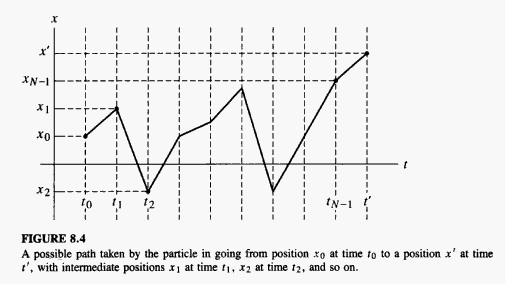Feynman Path Integrals
The path integral formulation of quantum mechanics was developed in 1948 by Richard Feynman. The path integral formulation is a description of quantum theory that generalizes the action principle of classical mechanics. It replaces the classical notion of a single, unique trajectory for a system with a sum, or functional integral, over an infinity of possible trajectories to compute a quantum amplitude.
The classical path is the path that minimizes the action.
This formulation has proved crucial to the subsequent development of theoretical physics, since it is apparently symmetric between time and space. Unlike previous methods, the path-integral offers us an easily method by which we may change coordinates between very different canonical descriptions of the same quantum system.
For simplicity, the formalism is developed here in one dimension.
In the path integral formalism, we start by writing the amplitude for a particle at position Failed to parse (SVG (MathML can be enabled via browser plugin): Invalid response ("Math extension cannot connect to Restbase.") from server "https://wikimedia.org/api/rest_v1/":): {\displaystyle x_0\!} at time Failed to parse (SVG (MathML can be enabled via browser plugin): Invalid response ("Math extension cannot connect to Restbase.") from server "https://wikimedia.org/api/rest_v1/":): {\displaystyle t=0\!} to move to a position Failed to parse (SVG (MathML can be enabled via browser plugin): Invalid response ("Math extension cannot connect to Restbase.") from server "https://wikimedia.org/api/rest_v1/":): {\displaystyle x\!} at time Failed to parse (SVG (MathML can be enabled via browser plugin): Invalid response ("Math extension cannot connect to Restbase.") from server "https://wikimedia.org/api/rest_v1/":): {\displaystyle t\!} as a path integral. This path integral is
Failed to parse (SVG (MathML can be enabled via browser plugin): Invalid response ("Math extension cannot connect to Restbase.") from server "https://wikimedia.org/api/rest_v1/":): {\displaystyle \langle x|\hat{U}(t)|x_0\rangle=\int_{x_0}^{x}D x(t')\,e^{iS[x(t')]}, }
where Failed to parse (SVG (MathML can be enabled via browser plugin): Invalid response ("Math extension cannot connect to Restbase.") from server "https://wikimedia.org/api/rest_v1/":): {\displaystyle S[x(t)]\!} is the action for the the path Failed to parse (SVG (MathML can be enabled via browser plugin): Invalid response ("Math extension cannot connect to Restbase.") from server "https://wikimedia.org/api/rest_v1/":): {\displaystyle x(t')\!} and the integral is defined as
Failed to parse (SVG (MathML can be enabled via browser plugin): Invalid response ("Math extension cannot connect to Restbase.") from server "https://wikimedia.org/api/rest_v1/":): {\displaystyle \int_{x_0}^{x}D x(t')=\lim_{N\to\infty}\left (\frac{m}{2\pi i\hbar\,\delta t}\right )^{N/2}\left (\prod_{j=1}^{N-1}\int dx_j\right ),}
where Failed to parse (SVG (MathML can be enabled via browser plugin): Invalid response ("Math extension cannot connect to Restbase.") from server "https://wikimedia.org/api/rest_v1/":): {\displaystyle N\!} is a number of "slices" of length Failed to parse (SVG (MathML can be enabled via browser plugin): Invalid response ("Math extension cannot connect to Restbase.") from server "https://wikimedia.org/api/rest_v1/":): {\displaystyle \delta t\!} that we divide the time axis up into. Essentially, we define the path integral as a limit of an integral over all possible values of the particle's intermediate positions on its path from Failed to parse (SVG (MathML can be enabled via browser plugin): Invalid response ("Math extension cannot connect to Restbase.") from server "https://wikimedia.org/api/rest_v1/":): {\displaystyle x_0\!} to Failed to parse (SVG (MathML can be enabled via browser plugin): Invalid response ("Math extension cannot connect to Restbase.") from server "https://wikimedia.org/api/rest_v1/":): {\displaystyle x.\!} Our assumed form of the propagation amplitude implies the following relation:
Failed to parse (SVG (MathML can be enabled via browser plugin): Invalid response ("Math extension cannot connect to Restbase.") from server "https://wikimedia.org/api/rest_v1/":): {\displaystyle \Psi(x,t)=\int_{x_0}^{x}D x(t')\,e^{iS[x(t')]}\Psi(x,0)}
The action is given by the time integral of the Lagrangian, just as in classical mechanics: Failed to parse (SVG (MathML can be enabled via browser plugin): Invalid response ("Math extension cannot connect to Restbase.") from server "https://wikimedia.org/api/rest_v1/":): {\displaystyle S[x(t')]=\int_0^t dt' \mathcal{L}[x(t'),\dot{x}(t'),t'], }
where Failed to parse (SVG (MathML can be enabled via browser plugin): Invalid response ("Math extension cannot connect to Restbase.") from server "https://wikimedia.org/api/rest_v1/":): {\displaystyle \mathcal{L}[x(t'),\dot{x}(t'),t']=\frac{1}{2}m\dot{x}^2(t')-V(x(t'),t') }
is the Lagrangian.
Knowing the propagator, we can calculate the probability that a particle at position Failed to parse (SVG (MathML can be enabled via browser plugin): Invalid response ("Math extension cannot connect to Restbase.") from server "https://wikimedia.org/api/rest_v1/":): {\displaystyle x_0\!} at Failed to parse (SVG (MathML can be enabled via browser plugin): Invalid response ("Math extension cannot connect to Restbase.") from server "https://wikimedia.org/api/rest_v1/":): {\displaystyle t=0\!} will be at Failed to parse (SVG (MathML can be enabled via browser plugin): Invalid response ("Math extension cannot connect to Restbase.") from server "https://wikimedia.org/api/rest_v1/":): {\displaystyle x\!} at time Failed to parse (SVG (MathML can be enabled via browser plugin): Invalid response ("Math extension cannot connect to Restbase.") from server "https://wikimedia.org/api/rest_v1/":): {\displaystyle t\!} by taking the absolute value squared.
As a justification of this method, we will show that it reproduces the Schrödinger equation. Let us begin by assuming that the elapsed time Failed to parse (SVG (MathML can be enabled via browser plugin): Invalid response ("Math extension cannot connect to Restbase.") from server "https://wikimedia.org/api/rest_v1/":): {\displaystyle t\!} is so small, that we may approximate the path integral with a single "time slice".
Question: The Feynman path integral formulation of quantum mechanics is more complex than solving the Schrödinger equation to get the dynamics of a quantum particle, why this formulation is mentioned in the text books and where it may be useful?
Answer: As far as a single particle is concerned it is recommended to use Schrödinger equation of motion. However, to study a many particle system getting dynamics by means of Schrödinger equation is quite complicated and messy (let say sometimes impossible), while the Feynman path integral is a good tool for dealing with many particle problems by defining the field operators. More importantly, the generalization of quantum mechanics to relativistic problem can be done in terms of field theory via Feynman path integral formulation.
Explicit evaluation of the path integral for the harmonic oscillator can be found here File:FeynmanHibbs H O Amplitude.pdf
